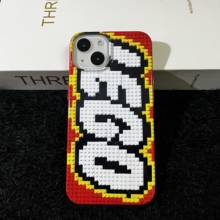iphone 手机壳 乐高多图
Lego Mindstorms,第一代Lego Mindstorms是建立在一个砖称为RCX (自动命令探险家)。 它包含一个8位瑞萨(当时日立的一部分) H8300单片机作为其内部CPU .它包括32K的RAM存储固件和用户程序。 砖是通过上传程序编程(写在几个可用的编程语言之一)从Windows或Mac电脑,砖的RAM通过一个特殊的红外线( IR )接口。 用户启动一个程序后,一个RCX-头脑风暴启用创作功能完全可以依靠自己的力量,作用在内部和外部刺激根据程序指令。 此外,通过红外接口,两个或几个RCX砖可以互相交流,使国际米兰砖合作和竞争。 除了IR端口以外,该系统包括三个传感器输入端口和三个输出端口(也可以被用来驱动其他电气设备,如灯等等)。 液晶屏可以显示电池电量的一个组成部分,输入输出端口的状态,选定程序或运行和其他信息。 [引文需要]版本1.0 RCX砖功能电源适配器插孔,以便连续运行而不是在使用电池时,操作时间有限。 在版本2.0 (以及包括在RIS 1.5后1.0s ),电源适配器杰克被删除。 固定电源适配器装备RCX砖是受欢迎的机器人项目(如机器人武器)或控制乐高模型火车。 在后者情况下,RCX需要用数字化指挥控制编程( DCC )软件操作多个有线列车。 在RCX的红外接口是能够与蠕虫变种病毒,斯科特砖、乐高火车,和NXT (使用第三方红外传感器的链接. ) 这RCX 1.0红外接收器的载波频率是38.5赫,而RCX 2.0 IR载波频率为76赫。 两个版本可以在任一频率传输。 载波信号是由RCX之一的内部计时器生成。 这RCX与使用一个串口或USB IR塔的计算机进行通信。 Windows 98支持塔,我,和XP ( 32位)。 修补程序可用超线程多核cpu。 没有正式支持Windows Vista ( 32位),但有正确的功能的报告。 USB塔在64位操作系统无法正常工作,除非32位操作系统与虚拟机一起使用。 串行塔64位windows 7下使用第三方usb到串口的适配器工作正常。 所有版本的RCX有一个唯一的编号印在它,必要的技术支持,并作为RCX的ID号为你的乐高头脑风暴现已Lego Mindstorms RCX网站上的帐户。 第一个生产的RCX被标记为" 000001 ",头脑风暴第十周年纪念活动上展出。 编程语言[编辑] LEGO MINDSTORMS程序是命令框编程,而不是编程。 乐高提供的语言:RCX代码(包含在MINDSTORMS玩具专业店出售消费者版本) ROBOLAB (基于LabVIEW和塔夫茨大学开发)流行的第三方语言:GNAT GPL:允许使用Ada语言编程NXT实时和嵌入式编程。 远:作为Java不完全是C:( NXC ),一个开源的类似于C的高级编程语言中,编译器从http:bricxcc下载。 开源版本。 净 NXC 不太C:( NQC ) RoboMind:简单的教育脚本语言,用于虚拟和乐高机器人机器人。 ROBOTC:基于C的编程语言和一个简单易用的开发环境。 仿真:图形信号处理和控制设计工具,它是自动生成的C代码和部署到NXT。 pbFORTH:对pbLua提出的扩展:Lua Visual Basic版本:通过COM +光盘上提供的接口 The first generation of Lego Mindstorms was built around a brick known as the RCX (Robotic Command eXplorers). It contains an 8-bit Renesas (then a part of Hitachi) H8300 microcontroller as its internal CPU. It included 32K of RAM to store the firmware and user programs. The brick is programmed by uploading a program (written in one of several available programming languages) from a Windows or Mac computer to the brick's RAM via a special infrared (IR) interface. After the user starts a program, an RCX-enabled Mindstorms creation can function totally on its own, acting on internal and external stimuli according to the programmed instructions. Also, two or several more RCX bricks can communicate with each other through the IR interface, enabling inter-brick cooperation or competition. In addition to the IR port, the system includes three sensor input ports and three motor output ports (which can also be used to drive other electrical devices such as lamps and so forth). An integral LCD can display the battery level, the status of the inputoutput ports, which program is selected or running, and other information.[citation needed] Version 1.0 RCX bricks feature a power adapter jack to allow continuous operation instead of the limited operation time when using batteries. In version 2.0 (as well as later 1.0s included in the RIS 1.5), the power adapter jack was removed. Power adapter equipped RCX bricks are popular for stationary robotics projects (such as robot arms) or for controlling Lego model trains. In the latter context, the RCX needs to be programmed with Digital Command Control (DCC) software to operate multiple wired trains. The IR interface on the RCX is able to communicate with Spybots, Scout Bricks, Lego Train, and the NXT (using a third-party infrared link sensor.) The RCX 1.0 IR receiver carrier frequency is 38.5 kHz, while the RCX 2.0 IR carrier frequency is 76 kHz. Both versions can transmit on either frequency. The carrier signal is generated by one of the RCX's internal timers. The RCX communicates with a computer using a Serial or USB IR tower. The tower is supported by Windows 98, Me, and XP (32-bit). A patch is available for hyper-threadingmulti-core CPUs. There is no formal support for Windows Vista (32-bit), but there are reports of correct functionality. The USB tower does not work on a 64-bit OS unless a 32-bit OS is used in conjunction with a virtual machine. The serial tower works normally under 64-bit Windows 7 using a third-party USB-to-serial adapter. All versions of the RCX have a unique number printed on it, necessary for technical support and used as the ID number of the RCX for your Lego Mindstorms account on the now-defunct Lego Mindstorms RCX website. The first RCX produced is marked "000001" and was on display at the Mindstorms 10th Anniversary event. Programming languages[edit] LEGO MINDSTORMS' programming is command box programming, rather than code programming. Lego-supplied languages: RCX Code (included in the MINDSTORMS consumer version sold at toystores) ROBOLAB (based on LabVIEW and developed at Tufts University) Popular third-party languages: GNAT GPL: Allows programming NXT using the Ada language for real-time and embedded programming. LeJos: A port of Java Not eXactly C: (NXC), an open source C-like high-level programming language, download compiler from nxc Not Quite C: (NQC) RoboMind: Simple educational scripting language for virtual and LEGO NXT robots. ROBOTC: C-Based Programming Language with an Easy-to-Use Development Environment. Simulink: Graphical Signal Processing and Control Design tool from which C code is auto-generated and deployed onto the NXT. pbFORTH: Extensions to Forth pbLua: Version of Lua Visual Basic: Via the COM+ interface supplied on the CD
-
iphone 手机壳 乐高
-
iphone 手机壳 乐高
-
iphone 手机壳 乐高
-
iphone 手机壳 乐高
-
iphone 手机壳 乐高
-
iphone 手机壳 乐高
-
iphone 手机壳 乐高
-
iphone 手机壳 乐高
-
iphone 手机壳 乐高
-
iphone 手机壳 乐高
-
iphone 手机壳 乐高
-
iphone 手机壳 乐高
-
iphone 手机壳 乐高
-
iphone 手机壳 乐高
-
iphone 手机壳 乐高
-
iphone 手机壳 乐高
-
iphone 手机壳 乐高
-
iphone 手机壳 乐高
-
iphone 手机壳 乐高
-
iphone 手机壳 乐高
-
iphone 手机壳 乐高
-
iphone 手机壳 乐高
-
iphone 手机壳 乐高
-
iphone 手机壳 乐高
-
iphone 手机壳 乐高
-
iphone 手机壳 乐高

















